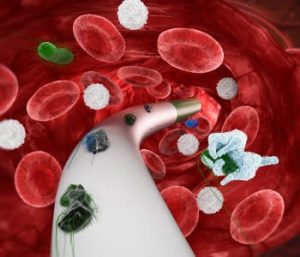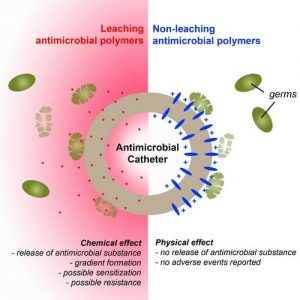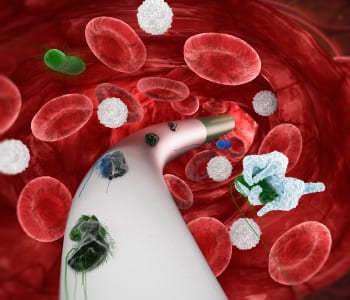 Antibiotic-resistant bacteria are a challenging threat to human life, especially in healthcare institutions. Since antibiotic weapons have become less effective due to fast evolving resistance mechanisms in the last decades, new antimicrobial strategies and materials beyond antibiotics are needed to prevent infections associated with medical devices, especially for indwelling devices. Bacterial colonization and growth on those devices lead to often life threatening infection development in the patient’s body.
Antibiotic-resistant bacteria are a challenging threat to human life, especially in healthcare institutions. Since antibiotic weapons have become less effective due to fast evolving resistance mechanisms in the last decades, new antimicrobial strategies and materials beyond antibiotics are needed to prevent infections associated with medical devices, especially for indwelling devices. Bacterial colonization and growth on those devices lead to often life threatening infection development in the patient’s body.
First and second generations of antimicrobial polymers were based on antimicrobial systems releasing antimicrobials from the device into the surrounding tissue to prevent bacterial colonization and growth on the device. Although many of these materials demonstrated good antimicrobial efficacy, these leaching additives are also often associated with negative side effects, such as development of resistant bacteria due to decreasing local concentrations of the additive or life threatening anaphylaxis due to a systemic release. Therefore, new developments with non-leaching antimicrobials, which reduce those risks and side effects, came to the center of attention. Here, only the surface is locally protected by a non-consumptive antimicrobial maintaining the antimicrobial efficacy of the device surface over time.
 In their current work, Bruenke et. al. have presented the first direct head-to-head comparison of antimicrobial efficacy between leaching and non-leaching antimicrobial materials by using central venous catheters (CVCs) as a clinically relevant model. Catheter-associated infections can develop rapidly into systemic bacterial infections in daily clinical life. The results of this study demonstrated equivalent antimicrobial efficacy of non-leaching CVCs compared to conventional leaching CVC-systems, protecting the device surface from bacterial colonization. Testing was performed against 7 different germs typically associated with CVC-related infections, including the most prominent bacteria Staphylococcus epidermidis and Staphylococcus aureus and also multi-resistant variants. These data represent an initial step to new non-leaching antimicrobial polymers and products, in which problems associated with leaching materials, such as release of bio-active substances, loss of antimicrobial activity and health risks due to biocide leaching, can be minimized. The applicability of these non-leaching antimicrobial materials to other polymer types and materials provides a potent new strategy to fight against device-associated multidrug infections.
In their current work, Bruenke et. al. have presented the first direct head-to-head comparison of antimicrobial efficacy between leaching and non-leaching antimicrobial materials by using central venous catheters (CVCs) as a clinically relevant model. Catheter-associated infections can develop rapidly into systemic bacterial infections in daily clinical life. The results of this study demonstrated equivalent antimicrobial efficacy of non-leaching CVCs compared to conventional leaching CVC-systems, protecting the device surface from bacterial colonization. Testing was performed against 7 different germs typically associated with CVC-related infections, including the most prominent bacteria Staphylococcus epidermidis and Staphylococcus aureus and also multi-resistant variants. These data represent an initial step to new non-leaching antimicrobial polymers and products, in which problems associated with leaching materials, such as release of bio-active substances, loss of antimicrobial activity and health risks due to biocide leaching, can be minimized. The applicability of these non-leaching antimicrobial materials to other polymer types and materials provides a potent new strategy to fight against device-associated multidrug infections.

















